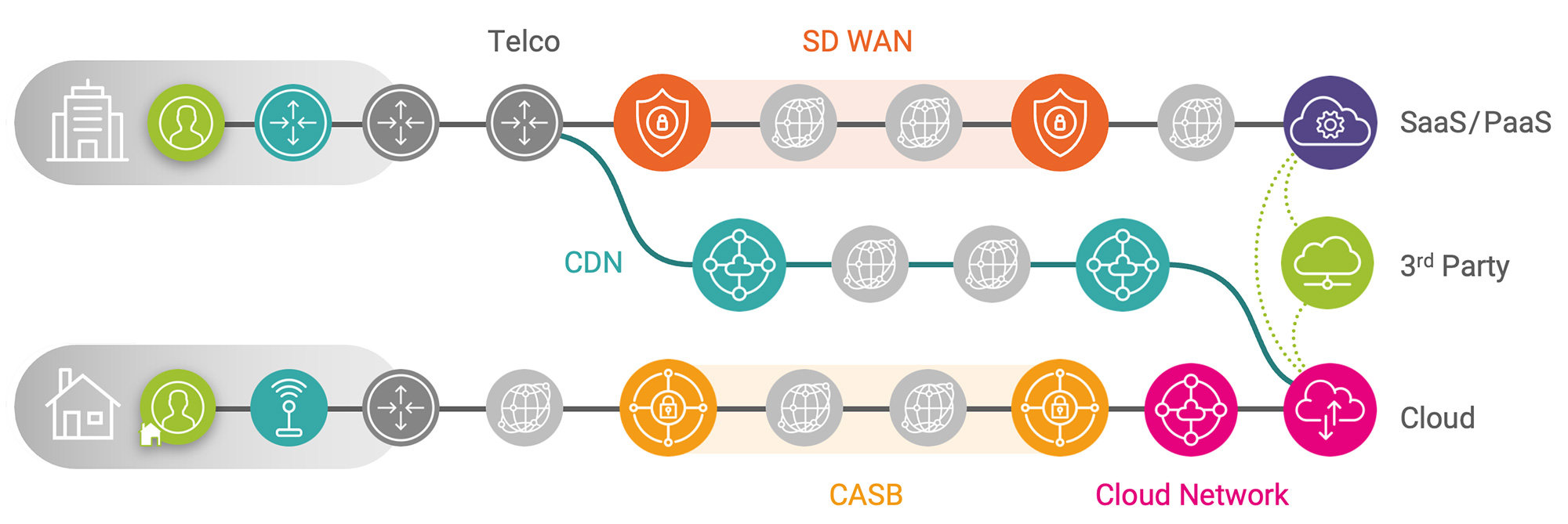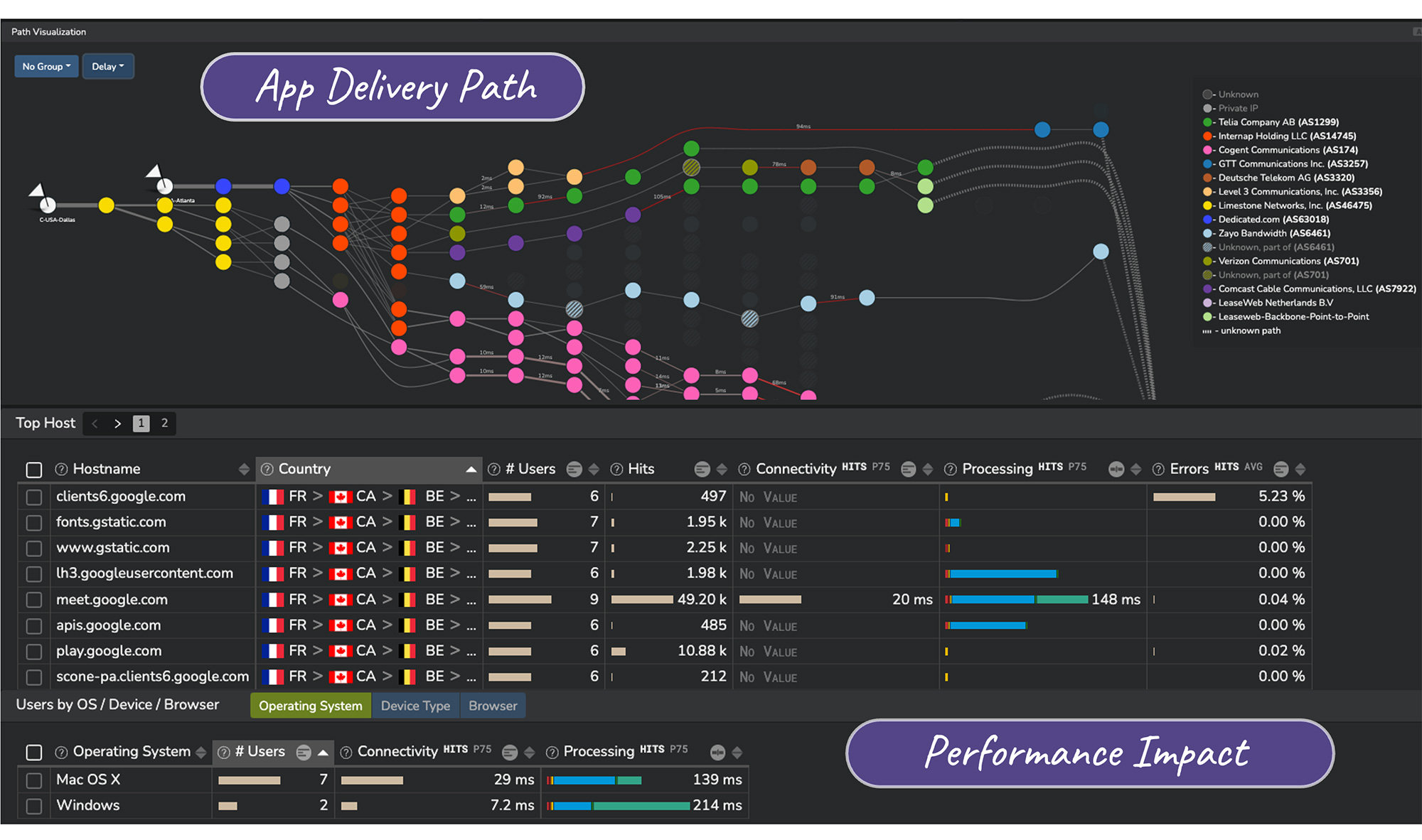The move to SaaS applications and cloud applications has radically changed IT operations’ ability to monitor and manage application performance in three ways
- PaaS and SaaS applications’ hosting infrastructure — including servers and operating systems — are out of your control and can’t be instrumented for network or application performance monitoring.
- CASB security, public networks and infrastructure between users and cloud, PaaS and SaaS applications introduce new connectivity issues that impact application performance management.
- Enterprise application integration across private, PaaS and SaaS applications results in new dependencies that impact application performance.
How can IT achieve optimal performance of SaaS applications and cloud applications that rely on third-party networks, cloud performance and hosting?
Can You Optimize Cloud and SaaS Application Performance?
Many IT professionals believe they can’t manage the optimal performance of PaaS, SaaS and third-party cloud applications, and as a result application performance monitoring isn’t effective or necessary.
While it is true that traditional network and application monitoring (NPM / APM) platforms fall short, newer solutions designed to monitor SaaS applications, cloud applications and dynamic internet-based network connectivity offer valuable insights to achieve optimal performance by revealing issues along modern application delivery chains. Let’s see how modern application performance relates to how they are hosted, delivered and consumed.
Application Performance Depends on an Optimal Delivery Chain
While PaaS, SaaS and cloud platform performance is out of IT’s control, digital experience monitoring platforms reveal that they account for less than 10% of the user experience. Optimal SaaS application and cloud application performance therefore depends on optimizing the performance of the delivery chain between the user and the application.
By focusing on the performance of internet-based connectivity, CASB security platforms, service providers, devices and browsers, IT teams can dramatically improve SaaS and cloud application performance. The SaaS and cloud application delivery chain is a series of third-party services:

How to Optimize SaaS Application Performance
To focus on what can be optimized, start with a clear understanding of the end-to-end infrastructure components SaaS and cloud applications encounter along the path to end users:
- The components along the application delivery chain
- The application performance impact of each
Here are some examples of latest-generation cloud and SaaS application performance monitoring that reveal the full application delivery chain, in context of the user experience and the scope of performance issues across regions, users, devices, browsers and network connectivity paths.

- Components you directly control
- Vendors you have a relationship with
- Providers or configuration within your vendors’ control (e.g. BGP route peering providers, cloud hosting locations)
- Providers you would prefer to remove from the delivery chain (e.g. avoid an operator by taking another route or using a CDN, reconfiguring your CASB security proxy routing, or changing DNS providers)
With actionable insight in hand, you can expect to have a productive, performance optimization conversation with:
- SaaS application vendors
- Packaged software vendors
- IaaS and PaaS providers
- Cloud providers
- Telecom, managed and internet service providers
- CASB security providers
How to Get Vendors to Fix Performance Issues
Vendors usually focus their own monitoring efforts on assuring service availability and meeting basic performance requirements. They are less concerned with how they indirectly affect application performance, even if degradations originate from within their infrastructure.
In fact, In many cases there is no easy way for them to understand how local changes impact the performance of SaaS applications, and interconnected cloud applications. For example, an operator is unlikely to track the effect of BGP policy updates on the latency between customers and clouds — even if the performance impact can be significant. This is where enterprise IT needs to step in and bring the issue to their attention.
Actionable data that objectively shows how their service impacts optimal application performance in terms they understand is the key to a productive conversation with any provider. Here are some examples:
- Telecom Service Providers
- A router adding latency or packet loss on a network path to your cloud services
- A change in BGP route increased latency and loss on route to your applications
- CASB Security Providers
- A redirection to a node which stands further away from a group of users, increasing latency
- A proxy processing on a given node which affects a set of your users
- SaaS Applications and Third-Party Vendors
- Incorrect DNS geo-location based redirections
- Transactions that correspond to slow processing times
- Integrated application components or CDN services which are not accessible from certain regions or ISP / broadband providers
- Cloud Providers
- Incorrect DNS geolocation-based redirections for SaaS applications, PaaS or cloud services
- Cloud network latency issues
Example: Optimal SaaS Application Performance Process
Our partner SeaTPI has been generous enough to share the details of an optimization process they followed to improve the performance of an Easyvista application (packaged software installed in their cloud) once application page load response times increased above 1 second.
The diagram below shows the application performance evolution over the course of a week. You can see the change in application performance as they progressively changed parameters at different levels of the application delivery chain:
-
- Paused web application firewalls – limited application performance optimization impact – not the root cause
- Optimized MS-SQL database indexes – small performance gains
- Cookie optimisation – a significant improvement, but not sufficient
- Restarted web application firewalls
- Requested analysis from application provider
- Vendor changed load balancer configuration – true root cause: response times reduced from 15 seconds to <1 second
Systematic SaaS Application Performance Optimization
This optimization process was guided by insight into all infrastructure layers and locations, from device to application across hybrid network connectivity. As performance degradations often result from a combination of factors, it’s important to systematically address the ones that appear to have the most impact, then reassess performance in this new context. Often another enhancement can be made to drive another level of improvement, or the first change may clarify a more subtle root cause that underlies the issue.
A complete 360° view across the entire application delivery chain — with the ability to validate actions in real time — is essential to quickly delegate issues to the correct team and have productive conversations with operators, IaaS, PaaS, SaaS, CASB security and application vendors. Actionable insight that quickly pinpoints probable root causes across modern infrastructure and enterprise application integration can make the difference between application performance management and optimization processes that take weeks to complete, or achieving optimal performance of cloud and SaaS applications within minutes or hours.
See how the Kadiska Digital Experience Platform’s guided analytics enables the fastest path to an amazing digital experience. LEARN MORE









